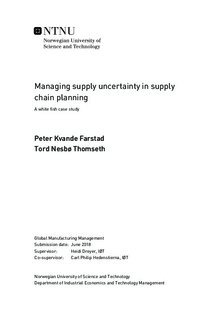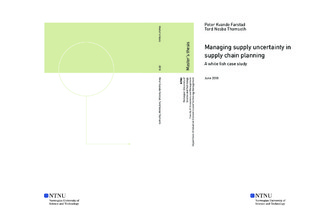| dc.description.abstract | This thesis investigates the impact of supply uncertainty on tactical supply chain planning processes. It focuses on identifying sources of supply uncertainty in a white fish processor s planning environment, and establishes a severity ranked list of these uncertainties.
Based on the most severe uncertainties, the thesis aims at proposing measures in the supply chain planning process which can be taken to mitigate the impact of supply uncertainty. The proposal takes the form of a planning process design, and can give white fish processors improved ability to increase capacity utilization, service levels and ultimately enhance the supply-demand balance. The thesis includes two research questions (presented below) which guided the research, each with two research objectives linked to it:
Research question 1: How does supply uncertainty impact tactical supply chain planning?
Research question 2: How can the tactical supply chain planning process be designed to mitigate the impact of supply uncertainties?
To date, there is no comprehensive review concerning the role and impact of supply uncertainty on the supply chain planning process, and how the planning process can adapt in the face of supply uncertainty. A systematic literature review and an exploratory single-case study are therefore conducted to theoretically and empirically explore how the tactical planning process is impacted by supply uncertainties. The case company is a Norwegian white fish processor and is chosen for its uniqueness, and the unit of analysis is the case company s tactical supply chain planning process.
Processors in the Norwegian white fish industry have experienced decreasing profitability, despite their immerse role as value creator and main employer in coastal communities. Several studies have drawn attention to the variability in raw material availability when trying to explain the negative trends in the industry. Supply uncertainties are often assured against in other industries by hedging inventory, sourcing from multiple suppliers or increasing capacity. However, in food supply chains and the white fish industry in particular, uncertainties must be mitigated against differently due to the seasonal and perishable nature of foods.
From the supply chain planning literature it was concluded that sales and operations planning (S&OP) was a recognized framework dealing with the tactical supply chain planning process, and the process parameters of importance was found as inputs, structure & processes and outcomes. The supply chain uncertainty literature suggested four sources of supply uncertainty: inherent characteristics, supplier related uncertainty, supply chain uncertainty and external uncertainty. These findings allowed for the development of a four-phase analyzing framework which purpose is to establish the impact of uncertainty on tactical supply chain planning processes. The framework therefore played a central role in answering research question 1.
Through semi-structured interviews it was identified 11 supply uncertainties, of which four were supplier related uncertainties. The most severe supply uncertainty was related to the case company s raw material forecast. Some critical characteristics of the tactical supply chain planning process was found to be high planning frequencies, disparate plans (made in separate spreadsheets), limited use of measurements and low integration with suppliers. The empirical data also showed an absence of supply chain analytics.
The thesis proposes a design of the tactical supply chain planning process that takes into account the most severe supply uncertainties. The design suggests integrating the suppliers in planning to reduce supplier related uncertainties. It also emphasize the need for an increased focus on information availability, mainly through more sophisticated IT systems and supply chain analytics, which could play an important role in reducing uncertainty related to accuracy of forecasts and plans. | |

